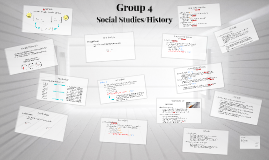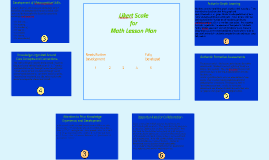Likert Scale
Transcript: Interpretation: the p value of 0 indicates that 0% of students chose this distractor PLAN has evolved into ACT Aspire it is no longer being administered (unless someone still remains under contract) it was administered to students in the 10th grade 145 questions in multiple choice format Malaine Kelley J.D. Not Steve Rachel Spongebob Katrina Marie Shania Anastasia Group 4 Median = 7 points or 70% Interpretation: 1/2 of the students scored below 7, while 1/2 of the students scored above 7 D value = .4 Interpretation: No D value can be calculated for this distractor because no student chose this answer; therefore, this is an ineffective distractor. ACT PLAN Item Analysis Easiest Items: 40 % of the students got this question right #2 Standardized Test 60% of students got #1 right 40% of students got #2 right 90% of students got #3 right 50% of students got #4 right 70% of students got #5 right 50% of students got #6 right 50% of students got #7 right 90% of students got #8 right 70% of students got #9 right 80% of students got #10 right Mode = 7 (70%) Interpretation: the most obtained raw score was 7 (which equals a "C") Interpretations of D Values Created By: Stacy A. Amanda D. Steven M. Alex S. ACT PLAN #2 - Which of the following dates did the Allies begin the assault on Normandy during the Second World War? a. June 6, 1943 p=.5; D= -.6 b. July 6, 1943 p=0; D= 0 c. January 6, 1944 p=.1; D=.2 d. June 6, 1944 (correct answer) p=.4; D=.4 How the school system uses the test score? p values & interpretations of the test items: English, Math, Reading, and Science this test shows how proficient a student is in a subject, and which area(s) need to be improved prior to taking the ACT 20% 50% 60% 60% 70% 70% 70% 80% 80% 90% b. July 6, 1943 D=0 Class Mean How to interpret the test scores? www.act.org www.act.org/plan/results.html www.act.org/planstudent/score/ #2 - Which of the following dates did the Allies begin the assault on Normandy during the Second World War? a. June 6, 1943 b. July 6, 1943 c. January 6, 1944 d. June 6, 1944 (correct answer) p = .4; D = .4 Statistical Information: focused on the attitude towards social studies How and when is it administered? C. January 6, 1944 D=.2 Likert Scale this test assessed the knowledge of various subjects that make up social studies as a whole there were 10 questions -- each question worth 1 point What does it measure? test scores range from 1-32 each section is graded individually and then the composite score is determined by averaging out each section graded similar to the ACT -- 15 or below (student is not on track); 16-24 (student is average); 25-32 (student is proficient in their grade level p values of the distractors: 2/10 5/10 6/10 6/10 7/10 7/10 7/10 8/10 8/10 9/10 Item Analysis #2 - Which of the following dates did the Allies begin the assault on Normandy during the Second World War? a. June 6, 1943 p=.5 b. July 6, 1943 p=0 c. January 6, 1944 p=.1 d. June 6, 1944 (correct answer) p=.4; D=.4 Likert Results the test enables parents to see exactly which area(s) their child needs to work on in order to be as successful as possible in their future parents are able to see what their child needs to focus on for the ACT Item Analysis Range = 7 [9-2 = 7] Interpretation: The range between the scores was 7 points Item Analysis Individual Test Scores (Raw Scores & Percentages) a. June 6, 1943 D= -.6 #8 - Which of the following branches includes the President of the United States? a. Legislative b. Executive (correct answer) c. Judicial d. none of the above Hardest Item: Interpretation: the p value of .5 indicates that 50% of students chose this distractor How the scores can be explained to a parent or guardian? a. June 6, 1943 p=.5 Likert Results b. July 6, 1943 p=0 the overall class mean = 42.8 this indicates that the class had a positive attitude towards social studies #3 - Which of the following languages did Roman citizens use to speak and write? a. Gaelic b. Greek c. Latin (correct answer) d. Roman D values of the distractors: Interpretation of D values 1. p = .6 2. p = .4 3. p = .9 4. p = .5 5. p = .7 6. p = .5 7. p = .5 8. p = .9 9. p = .7 10. p =.8 total points possible: 50 lowest score = 33 although this was the lowest score, it is still a positive attitude toward social studies What type of test scores are reported? Standard Deviation = 1.86 Interpretation: a mean of 6.5 and a SD of 1.86 shows that majority of students scored between 4.64 and 8.36 for the distractors total points possible: 50 Highest Score = 48 indicates a positive attitude towards social studies Item Analysis of the distractors How is it scored? c. January 6, 1944 p=.1 of the distractors ACT PLAN Mean = 6.5 points or 65% Interpretation: "D" was the average test score ACT PLAN the number of correctly answered questions in each section is translated into a score between 1 and 32 the complete score is determined by adding and averaging each score from each section and rounding it to a whole

















